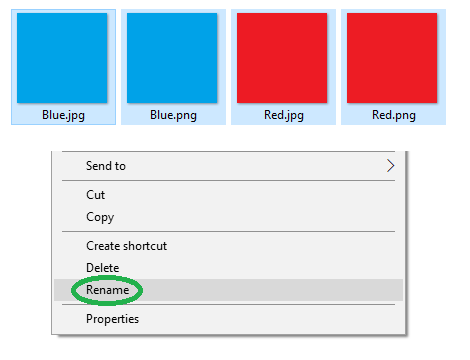
- #Batch file rename files to .jpg how to#
- #Batch file rename files to .jpg portable#
- #Batch file rename files to .jpg windows#
If you want to prefix it, move the "-test" part of the command forward, like so: ren *.* test-?.* Batch delete parts of the file name The second part (with all question marks) requires the command to use the existing filename up to 7 characters, but add "-test" as a suffix, while the asterisk again means apply for any file extension. *" Means to find any filename, with any extension, in this directory. In this command, the asterisk wildcard works in place of any character. How about adding suffix to a file group? You can do that by using the following command: ren *.* ?-test.* Here, the question mark wildcard acts like any character, allowing the command to find any matching file while exporting the renamed files. For example, if you want to change the digits in your filename you can use the following command: ren document?.txt document3?.txt If you want to rename multiple files, you can use wildcards to make the change. txt.Ĭonvert alphanumeric parts in multiple files The above command will rename all files with extension from *. If you want to change the extensions of multiple files at once, use the command: ren *. Once that's done, all the files in that folder will be renamed to the new one and they'll keep the same extension. html files in the directory, the command would look like this: ren file *. A is the file extension, for example HTML, JPEG, TXT. Don't forget to replace " file " with the current file name and " name " with the new name you want to change. A command line window will appear in the location of the folder you selected.

#Batch file rename files to .jpg windows#
Right-click on any file name and select the command Open command windows here (Windows 7) or go to File Explore (Windows 8), select File menu > Open command prompt > Open command prompt. Access the folder containing the files that need to be batch renamed. Batch rename files without changing the extension
#Batch file rename files to .jpg how to#
But first let's learn how to batch rename files without changing the extension. It's much more flexible to rename files in batch using the command line, as it also allows you to change file extensions. For more advanced functions We will have to use the command line solution and Windows Powershell features.

This is a basic but inflexible solution, as it is not possible to change the file extension nor restrict or change the Windows automatic adding of sequence numbers. name the new file and press the Enter button or click your mouse to another location. To do this, select all the files you want to rename (hold down Ctrl while clicking on a file to select non-contiguous files), press the F2 button (or right-click the files, choose Rename ) and then import. Using Windows Explorer (Windows 7) and File Explorer (Windows 10/8 / 8.1) is probably the easiest way to batch rename multiple files on Windows. One of them being Sorted number.Storing technical libraries forces Windows users to find ways to manage files more efficiently, and one of the most effective solutions is to batch rename files. To set a sequentials in it, hit F2 to get into advanced mode, select Append to turn it on, IN the append text entry box Right click, in there is an array of things you can append.
#Batch file rename files to .jpg portable#
(350k Zip 666k portable executable, E-mail ware) "superb batch renamer" which is about 10 times more complex, will do sequential numbering additions in the Append section, or random, or about anything else you can think of. It only does one type of renaming, but for that type it does it well, it leaves extentions as is, I use a different program for that. YoSemiPic401, YoSemiPic402, YoSemiPic403. you can also put a tag on but I never used that feature. It will not allow manuel resort of the files prior to numbering (just alphabetical).

It is limited in length of all the file names (quantity of files at a time), due to the file loading method. It will load sorted As selected, then put simple sequential numbering on the files loaded in (use CTRL A when selecting whole folder so all files to be in order). I use it to rename many files for stringing in order. (156k zip 300k single executable portable app called renmfl.exe) It is very old, I could not find the authors site anymore.


 0 kommentar(er)
0 kommentar(er)
